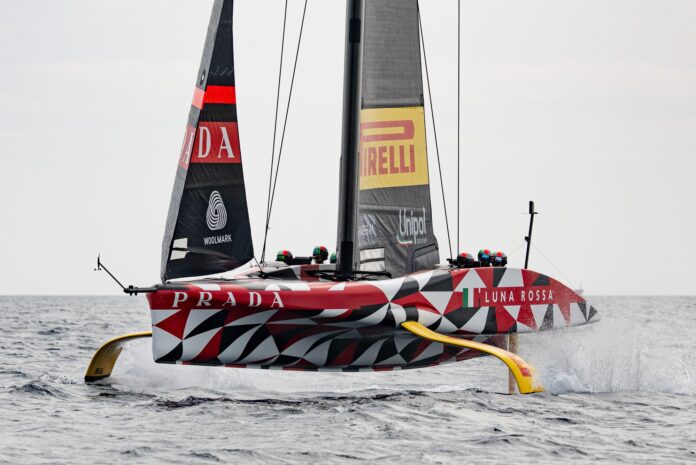Over in beautiful Cagliari, Sardinia, Luna Rossa Prada Pirelli kick-started their week with a flat-water session on their LEQ12 out on the Bay of Angels with a light breeze greeting the sailors on dock-out at 10am before building to a solid 15-17 knots by late morning, giving the whole team a near-perfect day of precision training whilst also bringing in members of the Italian Youth & Women’s teams for more training on the job.

Marco Gradoni, Ruggero Tita and Francesco Bruni shared the helming duties today on rotation and they were their usual fast and accurate self but one thing to really watch for on the video is the level of flight control excellence that the Italians have onboard this LEQ12. As the boat goes into rapid bear-aways and even faster round-ups, the immediate control that the Molineris/Bissaro/Tesei/Colaninno flight team have is just extraordinary. In flat water it’s amplified and where others go into a sky-rocket or nosedive, the Italians just keep it smooth. Equally upwind as the breeze came in, flight was menacingly low to the water’s surface and any mis-timed tack was quickly corrected – almost as if it was on a very advanced auto-pilot – which we know it isn’t. All credit to the flight team they are some of the elite of the America’s Cup world and could be key in Barcelona later this year.
Speaking afterwards, Andrea Zugna on of Luna Rossa’s key Performance Engineers, gave a terrific insight into the team and started with a summation of the day: “Well, pretty much drills around the racecourse, starts and then laps. Good breeze, mistral, so not so many waves so good day to refine the technique going precise, then when there are waves it’s more on the improvisation a bit more but today was good to have really good data and good academic data for us designers…we pretty much did all that was on the list.”

Drilling into the systems on the boat, Andrea was asked about symmetry and said: “On the top side not much in the end, yeah in a straight-line you can see performance differences but once you get to manoeuvres the rig part is asymmetric let’s say, while you have some difference in actuation in the flaps but you wouldn’t really tell much difference at this stage of the campaign”
Talking about the scaling factor that has been dominating the design team’s work going from 40 foot craft up to the AC75 with its varying loads, Andrea commented: “You have a theoretical scaling factor coming from the designers and then on the flight where you are battery powered it’s pretty straightforward while when the grinder’s will go on board we will know if our scaling factor was right or not!”

Less than two months now to the launch of the Luna Rossa Prada Pirelli AC75 that it’s hoped by Italian fans around the world, will deliver the Cup to Sardinia. The sailors look more than good – can they do it this time? That’s the question.
On-Water Recon Report – Luna Rossa Prada Pirelli: The Italian team rolled out their LEQ12 prototype at 8:30, stepped mast and craned the yacht in by 8:45. In addition to the usual checks, what seemed to be calibration test were executed with an aluminium beam placed perpendicular to the mast which rotated at designated angles. Shortly before dock-out at 10:00, the first iteration mainsail M1-1 was passed on deck. The prototype was towed out to hoist the main and pair it with the J1-1 considering the marginal breeze.

At 10:15, the latter was measured at 5-7kn from 345° with flat waters all across the Gulf. The LEQ12 was towed up three times but ended quickly off foils exiting each tack manoeuvre. As the light air vanished completely, the team paused for 40 minutes awaiting for any breeze. As some puffs seemed to fill in closer to shore, the prototype was towed up and now able to foil steadily. In light air, the four sailors practiced a series of manoeuvres working on slower manoeuvring technique with adjusted cant speeds and angles.
At 11:25, the pressure had suddenly ramped up to a higher range of 14-16kn from 315° and hence the J1-1 was lowered to hoist the J4-1. Sailors swapped and youth & women members boarded the prototype on the guest seats. A self-take-off followed and, once on the foils, the team rolled straight back to manoeuvre practice with a large amount of tacks, couple of gybes and another longer series of tacks.
In the meanwhile, top and bottom marks were being set and two pre-start drills were observed at 11:50. Then, the LEQ12 was decelerated after approximately 35 minutes for a quick lunch break.
As the second foiling stint began, two additional pre-start drills were practiced with, when on starboard entry, the previously seen full circle strategy around the committee boat entering the box. After the second one, an upwind and a downwind legs were sailed. During the whole day, the team executed a gybe following the bear away on the top mark and JKs prevailed on the bottom gate.
Additional legs followed the second of two additional pre-starts before the yacht was decelerated after 30 foiling minutes to swap sailors once again. The pressure seemed to shift further to 295° and decreasing slightly in strength. The LEQ12 was foilborne at 12:55 and the sixth solo prestart was then practiced, sailing two laps around the course.
As the sky cleared, the breeze picked up again and marks were collected during the last 30 minutes long foiling stint which saw the LEQ12 sail on the virtual track before straight-line sailing towards the harbour. The tow line was then passed, the day was called at 13:25 with 118 minutes foiling time,6 pre-starts, approximately 45 tacks and 35 gybes [Michele Melis AC Recon].






